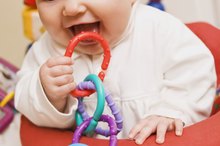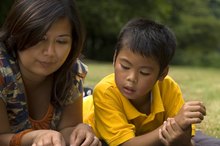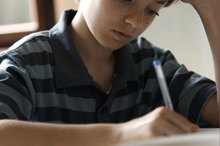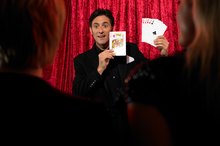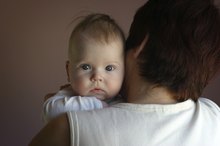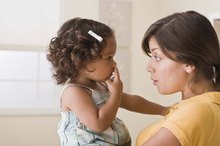Early Childhood Perceptual Development
- Sensorimotor Stage: Simple Reflexes
- Sensorimotor Stage: Primary Circular Reactions
- Sensorimotor Stage: Secondary Circular Reactions
- Sensorimotor Stage: Coordination of Secondary Circular Reactions
- Sensorimotor Stage: Tertiary Circular Reactions
- Sensorimotor Stage: Mental Combinations
- Preoperational Stage
Perception develops through information that is gathered from the senses, which allows children to make sense of their environment. As they grow, babies and young children learn to discern information from the environment that is significant to them. This ability to filter information helps children interpret and attach meaning to objects and events. Piaget’s stages of cognitive development describe the development of perception 2.
Sensorimotor Stage: Simple Reflexes
The simple reflexes substage is from birth to one month of age. At this age, infants begin to coordinate their inborn reflexes through sensation and action. They are born with reflexes that allow them to suck and grasp and they begin to follow objects with their eyes.
Sensorimotor Stage: Primary Circular Reactions
How Can Parents Help in the Sensorimotor Stage?
Learn More
From one to four months of age, infants begin to coordinate information from their senses. Infants intentionally repeat actions that occur automatically as reflexes. In this way, infants repeat behaviors they perceive as pleasurable, such as thumb sucking. Babies this age can also coordinate auditory and visual sensations by turning toward sounds.
- From one to four months of age, infants begin to coordinate information from their senses.
Sensorimotor Stage: Secondary Circular Reactions
This substage is from four to eight months of age. At this age, infants develop more coordination between vision and movement. Infants repeat actions that bring about interesting results, such as dropping a cup on the floor to see mom pick it up. Infants this age intentionally grasp objects. As they become mobile, their perception develops, and they gain spatial knowledge.
- This substage is from four to eight months of age.
- As they become mobile, their perception develops, and they gain spatial knowledge.
Sensorimotor Stage: Coordination of Secondary Circular Reactions
Visual Perception Problems in Children
Learn More
At eight to twelve months of age, babies develop object permanence, meaning taht they understand that objects still exist when they are out of sight. Their spatial perception develops, so they are able to crawl or walk toward interesting objects. Their coordination between vision and movement allows them to perceive behaviors as means to an end. In this way, their actions become goal oriented, and they may push a button on a toy to hear the sound it makes.
- At eight to twelve months of age, babies develop object permanence, meaning taht they understand that objects still exist when they are out of sight.
- In this way, their actions become goal oriented, and they may push a button on a toy to hear the sound it makes.
Sensorimotor Stage: Tertiary Circular Reactions
At 12 to 18 months of age, toddlers begin to experiment with new behaviors. They intentionally vary their actions to get interesting results. For example, a child this age may shake different rattles to hear the variations in sound from each one. They also perceive the different properties of objects and are curious about them.
- At 12 to 18 months of age, toddlers begin to experiment with new behaviors.
- They intentionally vary their actions to get interesting results.
Sensorimotor Stage: Mental Combinations
From 18 to 24 months of age, children develop symbolic thought 2. They can mentally represent events in their minds, allowing them to anticipate and perceive the consequences of certain actions. They are not confined to trial-and-error methods to obtain desired results because their perceptions of objects and events are stored in their memories.
- From 18 to 24 months of age, children develop symbolic thought 2.
- They are not confined to trial-and-error methods to obtain desired results because their perceptions of objects and events are stored in their memories.
Preoperational Stage
Between two and seven years of age, mental representations improve and objects do not have to be present for children to think about them. Younger children do not understand that others may perceive objects differently than they do. Older children are limited by centration. In Piaget’s beaker experiment, children did not recognize that the amount of water remained the same when it was poured into another beaker 2.
- Between two and seven years of age, mental representations improve and objects do not have to be present for children to think about them.
- Younger children do not understand that others may perceive objects differently than they do.
Related Articles
References
- A Child’s World: Infancy Through Adolescence, ninth edition; Diane Papalia, Sally Olds, Ruth Feldman; 2004
- The Psychology of the Child; Jean Piaget; 1972
- Bremner JG, Slater AM, Johnson SP. Perception of Object Persistence: The Origins of Object Permanence in Infancy. Child Development Perspectives. 2014;9(1):7-13. doi:10.1111/cdep.12098
- Kumar S, Shaw P, Giagkos A, Braud R, Lee M, Shen Q. Developing Hierarchical Schemas and Building Schema Chains Through Practice Play Behavior. Front Neurorobot. 2018;12:33. doi:10.3389/fnbot.2018.00033
- Piaget J. The Construction of Reality in the Child. Psychology Press. 1999.
- Moore MK, Meltzoff AN. New findings on object permanence: A developmental difference between two types of occlusion. Br J Dev Psychol. 1999;17(4):623-644. doi:10.1348/026151099165410
- Bremner JG, Slater AM, Johnson SP. Perception of Object Persistence: The Origins of Object Permanence in Infancy. Child Development Perspectives. 2015;9(1):7-13.
Writer Bio
Hillary Rolston began freelance writing in 2009. Her work has appeared on LIVESTRONG.COM, and areas of special knowledge include child and adolescent growth and development, and, in particular, the academic and emotional needs of children with disabilities. She is pursuing her Master of Arts and Education Specialist degrees in school psychology from the Citadel Graduate College.
